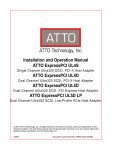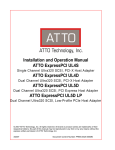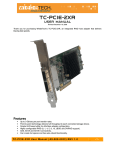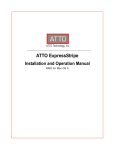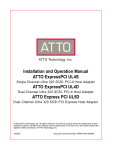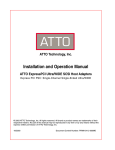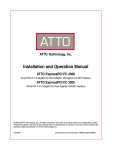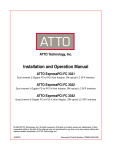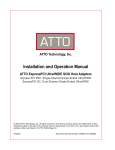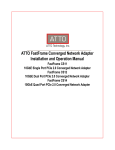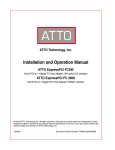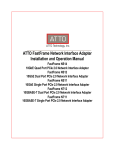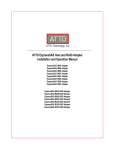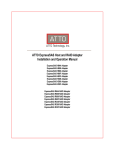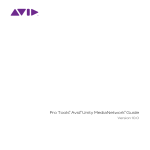Download ATTO Express PCI Host Adapters Installation and Operation
Transcript
ATTO Express PCI Host Adapters Installation and Operation Manual ATTO ExpressPCI UL4D Dual channel Ultra320 SCSI, PCI-X host adapter ATTO ExpressPCI UL5D Dual channel Ultra320 SCSI, PCIe host adapter ATTO ExpressPCI UL5D LP Dual channel Ultra320 SCSI, low-profile PCIe host adapter ATTO Technology, Inc. 155 CrossPoint Parkway Amherst, New York 14068 USA www.attotech.com Tel Fax (716) 691-1999 (716) 691-9353 Sales support: [email protected] Technical support: Monday -- Friday, 8am-6pm EST [email protected] Tel (716) 691-1999 x242 © 2010 ATTO Technology, Inc. All rights reserved. All brand or product names are trademarks of their respective holders. No part of this manual may be reproduced in any form or by any means without the express written permission of ATTO Technology, Inc. 2/2010 .............................................................................................................................................PRMA-0325-000MD Contents 1 ATTO ExpressPCI Ultra320 SCSI Solutions 1 Ultra 320 SCSI features Common features ExpressPCI UL4D Host Adapter UL4D Host Adapter ExpressPCI UL5D, UL5D LP Host Adapter UL5D Host Adapter UL5D LP Host Adapter ExpressPCI Ultra 320 Host Adapter selection guide 2 Hardware Installation 3 System requirements Installation 3 Installing and Updating Drivers, Flash 5 Install from the Installation CD Windows OS X Linux Appendix A Glossary ............................................................................................i Appendix B Cabling and Termination .................................................................iii Cabling Terminators Appendix C ATTO Product Guide .......................................................................v Appendix D Standards and Compliances ...........................................................vii Declaration of Conformity Appendix E Safety and Warranty ........................................................................viii Safety Installation Operation ATTO Technology, Inc. limited warranty 1 ATTO ExpressPCI Ultra320 SCSI Solutions The Ultra320 SCSI Host Adapter represents the seventh generation of SCSI technology, an I/O interface that is committed to increased performance while maintaining backward compatibility and legacy support. Today’s computing applications continue to strain the host PCI bus and storage subsystem. To bring better performance and reliability to today’s professional applications, the ATTO ExpressPCI UL4D adapter delivers up to 640 MB/sec. data throughput, and take advantage of the PCI-X bus interface while the ExpressPCI UL5D delivers data throughput rates of up to 640 MB/sec. using the latest in PCI bus technology, PCIe. ATTO ExpressPCI UL4D, UL5D and UL5D LP adapters deliver the high bandwidth demanded in data-intensive environments such as real-time and high-definition video editing, web server and database engines. To maximize your attached storage, you may wish to use RAID, a storage system using multiple disk drives to improve storage productivity and efficiency. Instead of using the RAID functionality built into Windows® OS, use the ATTO Express PowerCenter Utility for the most efficient performance. Contact your ATTO representative for more information. Common features • • • Ultra 320 SCSI features • • • • • • • • • • • Double Transition Clocking Domain Validation Cyclic Redundancy Check (CRC) Packetization Quick Arbitration Select (QAS) Free-Running Clock Read and Write Data Streaming Flow Control Training Pattern Pre-Compensation Asynchronous Information Protection (AIP) • • • • • • • Supports data transfer speeds of up to 320 MB/sec. per channel Supports Ultra320 Specifications including: • Packetized SCSI • Double transition clocking • Quick Arbitration Select (QAS) • Cyclical Redundancy Checking (CRC) • Domain Validation (DV) • Asynchronous Information Protection (AIP) • Free-running clock • Flow control Advanced Data Streaming (ADS™) provides controlled acceleration of data transfers. • Embedded RISC processor for low overhead • Bus mastering eliminates CPU processing time as a bottleneck • Tagged command queuing allows threads to be processed efficiently • Disconnect/reconnect eliminates wait time between transfers • Optimized scatter/gather lists Backward compatible with legacy SCSI devices ASPI (Windows) compatible Automatic and upper-byte termination Flash ROM for easy field upgrades RAID ready Environment and physical specifications • Operating temperature: 0-45oC • Humidity: 10-90% non-condensing • Airflow: 100 LFM (min.) Reliability • MTBF: 150,000 hours • MTTR: <15 minutes 1 ExpressPCI UL4D Host Adapter • • Accelerated PCI bus management • PCI Bus Master rate of 1-GB/sec. • PCI-X 1.0a compliant • PCI 2.2 compliant • 64-bit/133 Mhz PCI-X (backward compatible with standard PCI) Power • 0.75 typical/2.0 max. Amps @ + 5.0 /VDC • 0.05 Amps @ + 12.0 VDC UL4D Host Adapter • • • Two external VHDCI and two internal highdensity 68-pin connectors Supports up to 30 SCSI bus IDs (15 per channel) Dimensions • Length: 6.521” • Height: 4.450” ExpressPCI UL5D, UL5D LP Host Adapter • • Supports up to 30 SCSI bus IDs (15 per channel) PCI Express (PCIe) bus management • PCI Bus master rate 2-GB/sec. • PCI Express 1.0b compliant • Power • 1.61 typical/2.03 max. Amps @ +3.3 VDC • 0.65 typical/1.46 Amps @ + 12.0 VDC UL5D LP Host Adapter UL5D Host Adapter • • Two external VHDCI and two internal highdensity connectors. Dimensions • Length: 7.5” • Height: 4.376 “ • • • • Dual stacked external VHDCI connectors. Dimensions • Length: 6.6” • Height: 2.713” Power • 0.55 typical/0.9 max. Amps @ +3.3 VDC • 0.56 typical/0.59 max. Amps @ + 12.0 VDC Low-profile bracket available ExpressPCI Ultra 320 Host Adapter selection guide Dual Channel-- 2 independent channels Max. transfer rate LVD ExpressPCI Ultra 320 ExpressPCI Ultra 320 640 MB/sec 640 MB/sec • • 64-bit (PCI) • 32-bit (PCI) • 33 MHZ (PCI) • 133 MHZ (PCI-X) • x4 PCIe Bus ID support Part number • 30 30 EPCI-UL5D EPCI-UL5D LP EPCI-UL4D 2 ATTO Technology Inc. ExpressPCI Host Adapter Installation and Operation Manual 2 Hardware Installation Install the ATTO ExpressPCI Ultra320 Host Adapter and attach your SCSI devices to it using the instructions below. To get the best performance from your ATTO Express Ultra320 host adapters, use Ultra 320 SCSI devices. CAUTION 2 Remember to back up your system data before changing or installing hardware. Devices in the middle of the bus, including the ATTO ExpressPCI adapter, must have termination removed or disabled. ATTO ExpressPCI SCSI adapters select the proper termination if left in auto termination mode. System requirements The ATTO ExpressPCI host adapter package contains the host adapter, the ATTO ExpressPCI CD and a warranty and registration card. If any items are missing, contact your ATTO authorized sales representative. To install and use the ATTO ExpressPCI UL4DSCSI adapter you need: • A computer with an available 64-bit PCI-X expansion slot (preferred) or a standard 32- or 64-bit PCI expansion slot. • The complete ATTO ExpressPCI SCSI host adapter package. To install and use the ATTO ExpressPCI UL5D and ExpressPCI UL5D LP you will need • A computer with an available x4 PCIe expansion slot or larger, such as x8 or x16. • The complete ATTO ExpressPCI SCSI host adapter package. 3 Installation Remember to back up your system data before changing or installing hardware. 1 Plan your SCSI device connections. If connecting both internal and external devices to the ATTO ExpressPCI SCSI adapter, be sure to have the appropriate cables to connect devices. Set SCSI IDs. Each device on the SCSI bus requires a unique SCSI ID, one different from the host adapter ID. The default setting for the ATTO ExpressPCI adapter is 7. If you need to change this setting, refer to the ATTO Utilities Installation and Operation manual. Also refer to your SCSI device documentation to determine the current SCSI ID and how to change it. Wide (16-bit) SCSI devices can be assigned IDs 0 to 7 and 8 to 15, while Narrow (8-bit) devices can only be assigned IDs ranging from 0 to 7. 4 Review system documentation to select an appropriate slot to install your adapter. The combined power consumption of the expansion slots must not exceed the limits for your system. If you have more than one expansion card installed, ensure power consumption is within the limits outlined for your system. 5 Power down the computer and unplug the computer from all power sources. 6 Open the case. 7 Install the adapter in any open PCI expansion CAUTION ATTO ExpressPCI host adapters contain components that are sensitive to electrostatic discharge (ESD). ESD can cause damage to the ExpressPCI host adapter. Please follow standard methods to avoid ESD. Set SCSI device termination. Devices at both ends of the SCSI bus must be terminated. slot. Consult your computer’s documentation if you have questions about how to install an expansion card in your system. 8 Connect SCSI devices by inserting a SCSI cable to the connector on the ATTO ExpressPCI host adapter until you hear a click. Refer to Appendix B when selecting cables. 9 Close the computer case and power it up. ATTO ExpressPCI host adapters come preconfigured to operate properly in a variety of common system setups. However, some systems may benefit by tuning the adapter for optimal performance. Refer to the 3 ATTO Utilities Installation and Operation manual for more information on changing host adapter settings. Exhibit 2-1 Express PCI UL4D. Exhibit 2-2 ExpressPCI UL5D. Exhibit 2-3 ExpressPCI UL5D LP. 4 ATTO Technology Inc. ExpressPCI Host Adapter Installation and Operation Manual 3 Installing and Updating Drivers, Flash After installing the ATTO ExpressPCI Host Adapter, you must configure your system to recognize and use it by installing drivers for your operating system. Use the ATTO Configuration Tool found in the ATTO Utilities application from the ATTO website or on the Installation CD which comes with your adapter. Note If you already have one or more ExpressPCI adapters installed and you are installing additional adapter(s), you do not need to perform any of these procedures unless you are updating a previously installed driver. After installing the ATTO ExpressPCI Host Adapter, you must configure your system to recognize and use it by • installing drivers for your operating system • updating the adapter firmware if necessary ATTO ExpressPCI adapters ship with the latest firmware installed. If you are performing a new adapter installation, you do not need to update the firmware. If you are upgrading a previously installed driver, update the adapter firmware to ensure proper operation using the ATTO Configuration Tool in the ATTO Utilities application. The ATTO Configuration Tool is a utility program which displays information about installed adapters, drivers and devices and provides a mechanism to configure installed adapters. The ATTO Configuration Tool executes under • Windows Server 2008, 2003, 2000; Vista, XP • Linux® 2.4 (Fibre Channel only) and 2.6 kernels, x86 and x64 • Mac® OS X 10.4.x, 10.5.x • Sun Java version 1.5 or later • The latest runtime for Windows and Linux can be obtained from http://java.sun.com/javase/downloads/index.j sp • The latest OS X build can be obtained through Software Update. Java 1.5 is only available in 10.4.1 and later The ATTO Configuration Tool displays • The names of ATTO adapters installed in the system. • Information about the drivers controlling the adapters, including version information for both the currently executing driver and the flash image. • Information about the devices attached to ATTO adapters. You may also use the Configuration Tool to • Update the flash image when a new version is released by ATTO. • Modify the NVRAM settings. • Revert to default factory settings. The factory settings on your ATTO host adapter should provide excellent performance for a wide range of applications. However, some applications may benefit from modification of the adapter NVRAM settings which tune the adapter for a specific performance range. The ATTO Configuration Tool is included in the ATTO Utilities application on the Installation CD which came with your adapter. Refer to the ATTO Utilities Installation and Operation Manual for complete information on installing and using the application. Install from the Installation CD The CD which comes with your adapter contains drivers for your adapters and the ATTO Configuration Tool included in the ATTO Utilities application. Follow the instructions for your operating system. Windows 1 2 3 4 5 From the installation CD introductory screen, click on Windows Applications. Click on Install ATTO Configuration Tool. Launch the installer. Follow the on-screen instructions until the installation completes. Verify Java Virtual Machine (Java) version 1.5 or later is installed. From the command line prompt, type java -version. 5 OS X Linux 1 1 2 3 4 5 Check Software update to ensure the latest Java updates have been applied. Open the installation CD volume. Select the Configuration Tool folder. Launch the Configuration Tool. Follow the on-screen instructions until the installation completes. 2 Verify in the terminal window that the installed Java Virtual Machine (Java) is from Sun by typing java -version. The GNU version JVM which may be installed by default does not work with the installer. In the File Browser window, browse to /mnt/cdrom/Linux/Configuration Tool 3 Double click lnx_app_configtool_XXX.bin. 4 Follow the on-screen instructions until the installation completes. 6 ATTO Technology Inc. ExpressPCI Host Adapter Installation and Operation Manual Appendix A Glossary Some terms used in the storage industry are defined below. More information is available through the ATTO Technology website (www.attotech.com) and the SCSI Trade Association (www.scsita.org). Term Definition ANSI American National Standards Institute. Asynchronous Information Protection AIP: although most Ultra320traffic is sent synchronously and protected by CRC, some information is still sent asynchronously. AIP implements CRC-level error checking on asynchronous traffic ensuring end-to-end data integrity. bit Smallest unit of data a computer can process: a single binary digit with a value of either 0 or 1 byte An ordered set of 8 bits. CRC Cyclic Redundancy Checking, an error-correcting code which calculates a numeric value for received and transmitted data. If no error has occurred during transmission, the CRC for both received and transmitted data should be the same. destination address A value in the frame header of each frame which identifies the port in the node where the frame is being sent. domain validation Before sending data, domain validation verifies that the physical connection is capable of handling the negotiated transfer speed. If the system determines that Ultra320speeds are not feasible, a slower speed is enforced. double transition clocking Increases the data line frequency to equal that of the request signal, allowing sampling on both the leading and trailing edges of the request signal. Clocking can be set to ensure compatibility with legacy devices. flow control The target indicates to the initiator when the last packet of a data stream will be transferred so that the initiator can flush FIFOs and terminate pre-fetch sooner than previously possible. Basically, the target warns the initiator that the transfer is almost complete so that it can prepare for the next transfer while the target completes the current transfer. host A processor, usually a CPU and memory, which communicates with devices over an interface HVD High voltage differential: uses two wires, transmitting a signal on one and its inverse on the other. At the receiving end, the difference between the two signals is measured and interpreted. Noise on the bus will affect both the signal and its inverse equally, so the difference between the two lines will remain the same and the noise cannot be misread as a signal. initiator device A component which originates a command. LED Light-emitting diode: a type of diode that emits light when current passes through it. Visible LEDs are used as indicator lights on all sorts of electronic devices. LVD Low voltage differential. SCSI signalling method that combines the benefits of HVD and single-ended technologies, allowing longer cabling configurations while consuming less power than HVD technology. originator An initiating device; a component which originates a command. packetization Creates information units (IUs) from commands, data, status information, etc. which are passed as synchronous transfers. Maximizes bus use, minimizes command overhead and allows multiple commands to be transferred in a single connection. pre-compensation Although SCSI transfer speeds have changed dramatically over the past several generations, cable specifications have remained constant. Higher speed and frequency signals have a greater potential for reflection and distortion over distance. Pre-compensation techniques slightly modify the SCSI signal to reduce the chance of these types of problems. i Term Definition Quick Arbitration Select (QAS) Arbitration The process of devices negotiating for control of the bus with built-in “quiet times” so that fast and legacy devices have an opportunity to take control of the bus. A fair, but somewhat inefficient process, QAS speeds up the arbitration process by eliminating the bus free phase. When combined with packetization, reduces command overhead and maximizes bus use. read and write data streaming Minimizes data transfer overhead by allowing a target to send one data stream (LQ) packet followed by multiple data packets. Minimizes overhead of data transfers because the target can send one data stream packet followed by multiple data packets. receiver The ultimate destination of data transmission; a terminal device. SCSI Small Computer Systems Interface: a processor-independent standard for system-level interface between a computer and intelligent devices including hard disks, floppy disks, CDROM, printers, scanners, etc. single-ended An electrical signal protocol that transmits information through changes in voltage. Singleended SCSI uses standard TTL signal and ground pairs to transmit information over the SCSI bus. training pattern SCSI is a parallel bus technology that is dependent on signals being transmitted on parallel wires simultaneously. At higher speeds, minute differences in wire lengths and transmission characteristics could cause problems. Training pattern testing measures these minute differences and compensates for them. ii ATTO Technology, Inc. ExpressPCI Host Adapter Installation and Operation Manual Appendix B Cabling and Termination Cables and devices must be chosen to maximize performance and minimize the electrical noise. Use high quality Ultra 320-rated, well-insulated SCSI cables to ensure error free communications. Cabling and termination methods become important considerations. Cabling Total bus cable length varies by host adapter and type of attached devices. See Exhibit A-2 for details on maximum cable length. If you combine Wide 16-bit and Narrow 8-bit devices on the same connector, connect the Wide devices first (closest to the connector). Refer to the documentation for your SCSI devices to determine if they are Wide or Narrow, UltraWIDE SCSI, Ultra2 SCSI, Ultra160 or Ultra 320. The ExpressPCI Ultra320 SCSI Host Adapter supports two types of SCSI signaling: Low Voltage Differential (LVD) and Single-Ended. Devices on the same SCSI bus must use the same signaling, either LVD or Single-Ended. When setting up SCSI cabling, consider the following points. Terminators Use an LVD terminator if you are only using LVD devices. Although you can use a Single-Ended terminator, all devices will be limited to Ultra SCSI speeds. Single-Ended devices require a Single-Ended terminator. If you use an LVD terminator with Single-Ended devices, the system may hang or devices may not be seen on the SCSI bus. Some termination manufacturers provide automatically sensing terminators. External terminators should be attached to the last external device in the SCSI chain. Don’t use any other termination on the external SCSI chain. The last device on an internal SCSI chain should also be terminated in one of several ways. Many Single-Ended Ultra SCSI and earlier devices provide a jumper setting for applying termination: place a jumper over the pins designated for termination on the last device on the internal cable. Check with your drive manufacturer if you are not sure which pins to use. LVD Ultra2 and Ultra160 SCSI devices cannot supply their own termination. Use an internal ribbon cable which has a SCSI terminator attached to the end of it, connect the unterminated end of the cable to the host adapter card and the internal drives to the subsequent connectors. The terminator should be at the opposite end of the cable from the host adapter card. Wide (16-bit) and Narrow (8-bit) devices can be connected together on the same connector of the host adapter card, but wide devices must be attached first, followed by narrow devices. To terminate the SCSI bus, the cable or adapter used to convert from a wide (68-pin) connector to a narrow (50-pin) connector provides partial termination, allowing upper 8-bits (or byte) of the wide SCSI bus to be properly terminated. A narrow terminator should be used on the last narrow device to terminate the rest of the SCSI bus. A SCSI bus without partial termination between the wide and narrow devices may at first appear to work correctly, but occasional I/O errors occur without proper termination. If you use both internal and external connectors and mix Single-Ended and LVD devices on the same bus, even if using different connectors, the host adapter card will operate with Single-Ended signaling at UltraSCSI speeds. Automatic termination When both internal and external connectors are used, the host adapter card detects the presence of devices and turns off termination. If devices are removed from one connector of the card, the host adapter automatically detects the change, and enables its own termination. iii Software controlled termination You may have to override the host adapter’s automatic termination if only narrow devices are attached to one connector and wide devices are attached to the other connector on the same bus. The host adapter must supply partial termination to the upper 8-bits (byte), but not automatically. Please refer to your ATTOI Utilities manual for instructions on setting the host adapter’s termination to Upper Byte. manufacturer for more information on your device’s ability to supply termination power. Exhibit A-1 Several internal and external cable connectors. Termination power Host adapters supply termination power to the bus at all times and many SCSI devices are also able to supply termination power. SCSI signal quality, particularly with long or marginal quality cables, may be improved if the device supplies the termination power. Contact your device Exhibit A-2 The following table lists the maximum number of devices you may connect at specific cable distances using differential and single-ended SCSI in various SCSI environments. Max. bus lengths, meters Bus speed Bus width MB/sec. max. bits Single-ended LVD HVD SCSI-1 Fast SCSI Fast Wide SCSI Wide Ultra/WIDE SCSI Wide Ultra/WIDE SCSI Wide Ultra/WIDE SCSI Ultra2 SCSI Ultra160 SCSI Ultra320 SCSI 5 10 20 40 40 40 80 160 320 8 8 16 16 16 16 16 16 16 6 3 3 1.5 3 - 12 12 12 iv ATTO Technology, Inc. ExpressPCI Host Adapter Installation and Operation Manual 25 25 25 25 - Max. device support 8 8 16 16 8 4 16 16 16 Appendix C ATTO Product Guide Contact an ATTO Technology authorized sales representative to order. Celerity selection guide Product Features Celerity FC-44ES Celerity FC-42ES Celerity FC-41ES FC-41EL Celerity FC-42XS Celerity FC-41XS 4 2 1 2 1 Fibre Channel Ports FC protocol Maximum Transfer Rate (half duplex) 4-Gb 4-Gb 4-Gb 4-Gb 4-Gb 1.6 GB/sec 800 MB/sec 400 MB/sec 800 MB/sec 400 MB/sec Maximum Transfer Rate (full-duplex) 2 GB/sec 1 GB/sec (ES) 1.6 GB/sec (EN) 800 MB/sec 1 GB/sec1 800 MB/sec Bus Type PCIe PCIe PCIe PCI-X PCI-X Bus Characteristics 8 lane 4 lane 4 lane 64-bit 133 MHz 64-bit 133 MHz2 SFP LC SFP LC SFP LC Optical Interface Maximum Cable Length Low Profile form factor ATTO Advanced Data Streaming (ADS) Technology Software RAID support3 Developer's Kit (Target Mode & API) Windows Server 2008, 2003, 2000; Vista, XP support Linux (Red Hat, SUSE) driver Mac OS X driver Novell Netware support Solaris support Free BSD RoHS compliant SFP LC SFP LC 300m@2-Gb 150m@4-Gb 300m@2-Gb 150m@4-Gb 300m@2-Gb 300m@2-Gb 300m@2-Gb 150m@4-Gb 150m@4-Gb 150m@4-Gb • • • • • • • • • • • • • • • • • • • • • • • • • • • • • • • • • • • • ES only • • • • ES only • • • • ES only • • • • • • • 1 Performance ceiling is constrained by 133 MHz PCI-X bus transfer speed 2 Backward compatible to 32-bit and 33 MHz PCI 3 ATTO ExpressStripe for OS X available; Express Power Center and other software RAID supported for Windows v ExpressSAS selection guide ATTO ExpressSAS RAID Adapters Product Features Max.transfer rate1 (full duplex) x8 PCI Express Number of ports Port configuration external/internal Connector type Number of devices supported RAID Management Utility Global Hot Spares Event notification Memory (ECC) Advanced Data Streaming™ Battery backup R380 4 GB/sec. 4 GB/sec. • • 8 8 4/8 8/0 user selectable 4/4 or 0/8 1 mini SAS (x4) SFF-8088 external 2 mini SAS (x4) SFF-8088 external 2 mini SAS (x4) SFF-8087 internal 64 SAS/SATA targets 64 SAS/SATA targets 128 virtual devices 128 virtual devices 1.5 Gb SATA support 3 Gb SATA II support 3 Gb SAS support Cable distances Integrated RAID R348 0, 1, 4, 5, • • • • • • up to 8m 10, 50, 602, JBOD, DVRAID 6 2, 0, 1, 4, 5, up to 8m 10, 50, 602, JBOD, DVRAID 62, • • • • E-mail, pop-up, log file 258 MB standard 512 upgradeable (OEM) E-mail, pop-up, log file 258 MB standard 512 upgradeable (OEM) • • optional optional 32-bit support 64-bit support • • • • Windows Server 2008, 2003, 2000; Vista, XP • • • Linux (Red Hat, SUSE) support • Mac OS X support • RoHS compliant • Low profile 1 Performance ceiling constrained by PCIe bus transfer speed 2 Future support vi ATTO Technology, Inc. ExpressPCI Host Adapter Installation and Operation Manual • • • • Appendix D Standards and Compliances The equipment described in this manual generates and uses radio frequency energy. The Technical Specification sheet for a particular ATTO ExpressPCI Host Adapter lists certifications for that model. FCC standards: radio and television interference This equipment has been tested and found to comply with the limits for a Class A digital device, pursuant to Part 15 of the FCC Rules. These limits are designed to provide reasonable protection against harmful interference in a residential installation. This equipment generates, uses, and can radiate radio frequency energy and, if not installed and used in accordance with the instruction manual, may cause interference to radio communications. However, there is no guarantee that interference will not occur in a particular installation. If this equipment does cause interference to radio or television reception, which can be determined by turning the equipment off and on, the user is encouraged to try to correct the interference by one or more of the following measures: • Reorient or relocate the receiving antenna • Increase the separation between the equipment and receiver • Connect the equipment into an outlet on a circuit different from that to which the receiver is connected • Consult the dealer or an experienced radio/TV technician for help Canadian standards This Class A digital apparatus complies with Canadian ICES-003. Cet appareil numérique de la classe A est conforme à la norme NMB-003 du Canada. European standards Declaration of Conformity This following statement applies to the ATTO ExpressPCI Host Adapter. This device has been tested in the basic operating configuration and found to be compliant with the following European Union standards: Application of Council Directive: 89/336/EEC Standard(s) to which conformity is declared: EN55024:2002; EN55022:2002 CLASS B This Declaration will only be valid when this product is used in conjunction with other CE approved devices and when the entire system is tested to the applicable CE standards and found to be compliant. The EPCI-UL4D-0R0, EPCI-UL4S-0R0, EPCI-UL5D-0R0 and EPCI-UL5D-L00 cards comply with Directive 2002/95/EC on the Restriction of the Use of Hazardous Substances in Electrical and Electronic Equipment (RoHS). Contact your ATTO representative regarding RoHS compliant products. vii Appendix E Safety and Warranty All ATTO host adapter products have been tested to meet applicable safety standards when operated in proper electrical and thermal environments. Safety Please review the specifications for your specific host adapter before installing and operating it in any computer system to ensure compatibility. Installation Before installing an ATTO host adapter product into your computer system, unplug the computer from its electrical power source and allow adequate time for electrical discharge and the internal components to cool down before removing the computer system cover. This will decrease the risk of personal injury from electrical shock or touching the hot surface of an electrical component. Once an ATTO host adapter is installed in a computer system, the computer cover must be reinstalled properly before turning the computer system back on. Operation ATTO host adapters require adequate cooling to function properly. If you have any questions as to the airflow provided by your computer system, please refer to your computer system manual or contact your computer system manufacturer. To facilitate proper air circulation, ATTO host adapters should never be operated in a computer system without the cover installed or with an inoperable fan as this may cause safety or thermal problems which could damage the ATTO host adapter and void the warranty. ATTO Technology, Inc. limited warranty ATTO Technology, Inc. warrants to the original purchaser of this product that it is free from defects in material and workmanship as described in the ATTO Technology website, www.attotech.com. ATTO Technology, Inc. liability shall be limited to replacing or repairing, at its option, any defective product. There is no charge for parts or labor should ATTO Technology, Inc. determine that this product is defective. Products which have been subject to abuse, misuse, alteration, neglected, or have been serviced, repaired or installed by unauthorized personnel shall not be covered under this warranty provision. Damage resulting from incorrect connection or an inappropriate application of this product shall not be the responsibility of ATTO Technology, Inc. Liability is limited to ATTO Technology, Inc.product(s); damage to other equipment connected to ATTO Technology, Inc.product(s) is the customer’s responsibility. This warranty is made in lieu of any other warranty, express or implied. ATTO Technology, Inc. disclaims any implied warranties of merchantability or fitness for a particular purpose. ATTO Technology, Inc. responsibility to repair or replace a defective product is the sole and exclusive remedy provided to the customer for breech of this warranty. ATTO Technology, Inc. is not liable for any indirect, special, incidental, or consequential damages irrespective of whether ATTO Technology, Inc. has advance notice of the possibility of such damages. No ATTO Technology, Inc. dealer, agent or employee is authorized to make any modification, extension or addition to this warranty. viii ATTO Technology, Inc. ExpressPCI Host Adapter Installation and Operation Manual

















